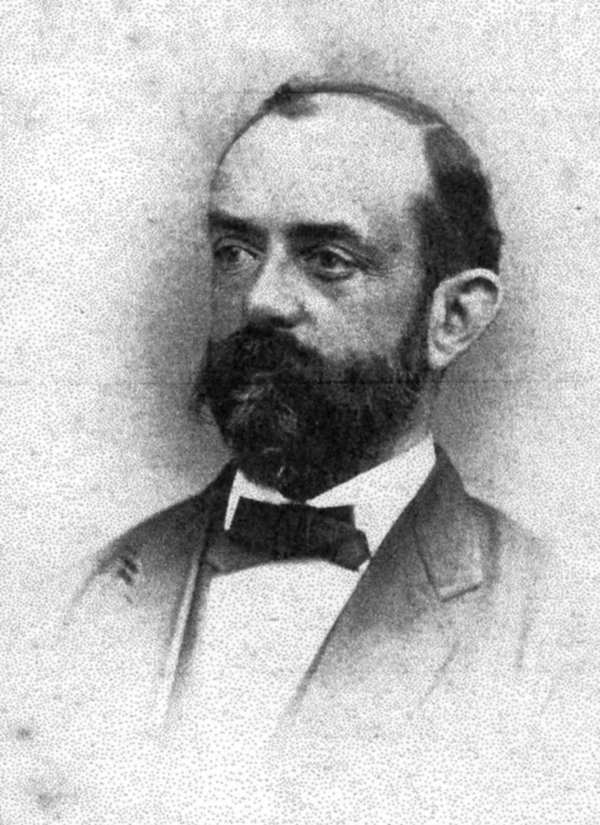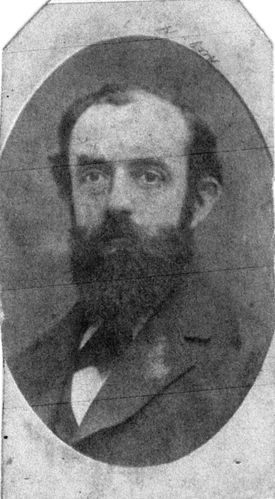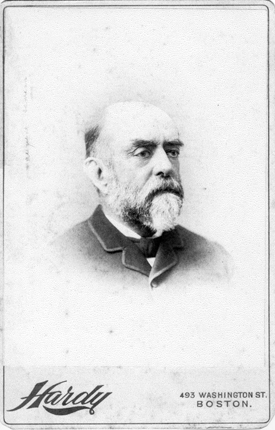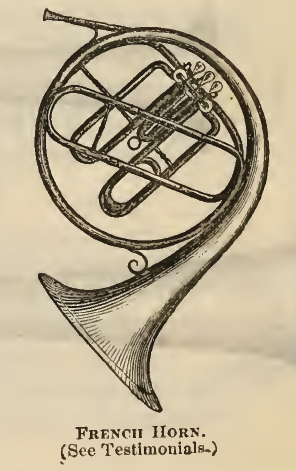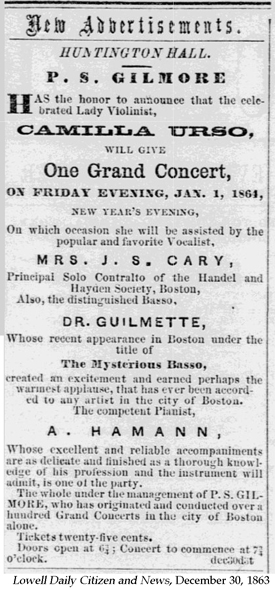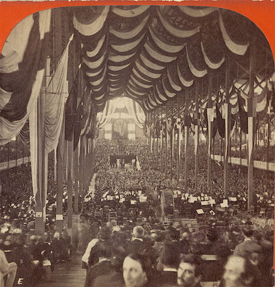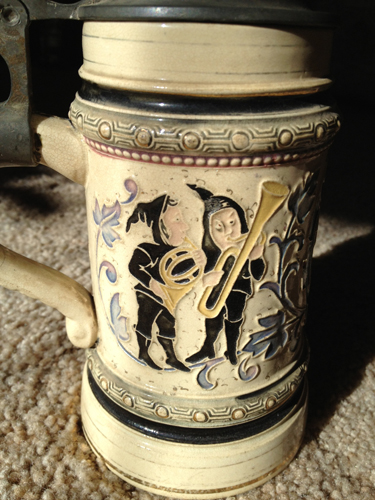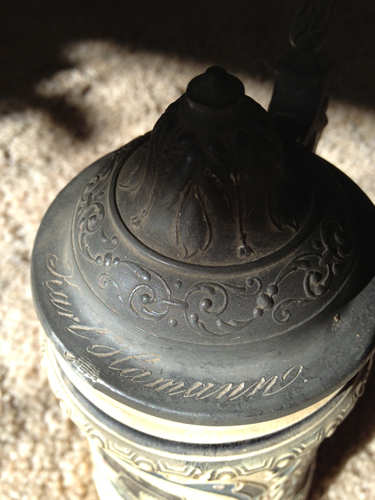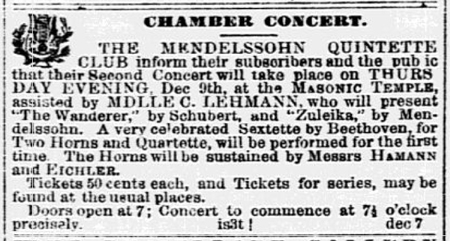Notes
1. Estimates of Mr. Hamann's birth year
found in public records vary from as early as 1826 to 1830. His
statement on naturalization documents state 1829, however family
records indicate 1827 which is used here. For most of his life
Mr. Hamann used only the given name, August, however there are
several references in Boston and Somerville city directories
where he is named C. August Hamman. He, like many in his
generation, was probably named after
the great German reformer,
Karl
(or Carl or Charles) August (1757 -
1828), Grand Duke of Saxe-Weimar-Eisenach.
So well liked in Berlin because of his relationship with
Prussia, the famous Karl-August-Platz in Berlin (Mr. Hamann's
birthplace), was named for him in 1897 almost seventy years
after his death. That Mr. Hamann was one of his many namesakes
is evidenced in particular, in the his notice of filing for
divorce from his first wife in 1869 where he states his name as
C. August Hamann, as do several city directories. In the 1892
Somerville directory, where he is also listed as "Hamann,
C. August, music teacher (449 Washington, B), house 262 Summer"
(corner of Cedar St.). Within the same listing is his son,
"Hamann, Charles A.,
Jr., bookkeeper (B.) , h. 69
Cedar". the latter address located just up the street from Mr.
Hamann's. Son, Charles A. Hamann married Alice B. Baker,
on August 11, 1889.
(back)
2. The newspaper clipping shown on this page
has the name "Rumpenhagen" which is also found in one
contemporary account but is certainly a misprint.
Carl
Friedrich Rungenhagen (1778- 1851) was a well-known
composer and music teacher in Berlin, and was undoubtedly
Hamman's teacher.
(back)
3. In the 1855 Massachusetts State Census,
August (29), Dorthe (55), Augusta (25), and Dorothea (7) are
listed living in Cambridge. Mr. Hamann's brother, John [or
Johan] Adolf Hamann was a very successful Jeweler in New York
City.
(back)
4. In addition to conducting theater
orchestras, Koppitz was professor of orchestration at Boston
University.
(back)
5. August Hamann appears in the Consolidated
List of all persons of Class II, subject to do military service
in the Fourth Congressional District consisting of a part of the
Counties of Suffolk and Middlesex Counties of Massachusetts.
Class I comprises all persons subject to do military duty
between the ages of twenty and thirty-five years, and all
unmarried persons subject to do military duty above the age of
thirty-five years and under the age of forty-five. Class II
comprises all other persons subject to do military duty. Mr.
Hamann was listed as being 37 years old.
(back)
6. The Massachusetts State Census,
taken on May 1, 1865 for Ward Four of Cambridge states that Lucy
was born in Haiti. In addition to the children listed above, the
household included Mr. Hamann's mother, Anna D. [Dorothea]
Hamann, age 63. Son Emory was listed as Emily H. (female) age 7
months. Mr. Hamann accused Lucy of adultery and published a
formal notice on July 8, 1869 naming Eugene Bowditch as
co-respondent. The full name of daughter Louisa (1867-68) was
Louisa Bowditch Hamann, and apparently August registered her as
his own daughter since he had not yet filed for divorce.
According to Boston birth records Lucy Bell and Eugene Bowditch
later had another daughter, Mabel Keith Bowditch born January
24, 1870. Following his divorce from Lucy, Mr. Hamann's mother
and two sons moved to Cincinnati to live with his sisters, Dora
and Augusta. The 1870 U.S. Federal Census for Cincinnati lists
the following: Dora Haman (53), Dora Haman (25), Augusta Haman
(30), Charles Haman (7) and Emery [
sic] Haman (5). Age
differences of mother Dora (Dorothe) and sister Augusta between
the 1855 census and 1870 might be due to vanity, while dates for
sister Dora (Dorothea), and sons Charles, and Emory are
consistent with other records. Custody of daughter Bertha
Jessica was awarded to her mother, Lucy. Following her divorce
from Mr. Hamann and her marriage to Mr. Bowditch, Lucy married
Dr. John Foye with whom she had a son John Wilson Foye
(1875-1890) and the family moved to California. Bertha Jessica
took the name Foye and married a Mr. Clayton. Mabel Keith
Bowditch also took the name of Foye as a child, and later
became an actress under the name of Mabel Keith. She married
Clarence Fitzgerald with whom she had a son, Bertram L.
Fitzgerald (1895-1974). Mabel died February 22, 1909. Lucy
Bell's fourth husband was Charles G. Lidstrom (or Leidstromm) of
San Francisco. Lucy and her son John Foye were killed in an
avalanche in Logansville, California on January 17, 1890;
Mr. Lidstrom's life was spared in the snow slide. Mr. Hamann's
sister Augusta never married, however as noted in the clipping
above, his other sister, Dora, married Mr. Max M. Peyser in
Cincinnati, but with tragic results:
A Strange Story. The Cincinnati Enquirer
tells a strange story of the sudden death of a wealthy
citizen, his lunacy, marriage, and strange ending. It says
that Mr. Henry Strasberg, a merchant, yesterday called on
Coroner Maley and demanded to have an inquest on the body of
Max M. Peyser, a merchant on Fourth street, who died under
what is considered suspicious circumstances. Mr. Peyser had
married the day before his death, and was sitting, on the
morning of his death, at the breakfast table. He then
complained of pain, stood up, went into an adjoining room and
fell dead. Dr. Barholow was called in, and he, together with a
student of Good Samaritan Hospital, cut open Peyser's body,
and prepared to hold a post-mortem examination.
Upon what authority he did this is not stated. The Coroner
immediately took the matter in charge and took the contenst of
the man's stomach into his posession for analysis. Dr.
Bartholow gave the cause of Peyser's death as consumption. The
history of the case is a strange one. Peyser had
been a successful merchant on Fourth street up to about seven
months ago, when he became crazy. On a writ from the
Probate Court he was sent to the Longview Asylum, and Mr. N.
Bettmann was appointed administrator of his estate, which was
valued at $50,000. At Longview he seemed to grow better, and
about six weeks ago he was let out, when he resumed charge of
his affairs. On Thursday last he married Miss Dora M.
Hamann, a lady of about thirty-five, (Peyser was about fifty
[40 years, 1 month, and 20 days according to the death
notice], who had for ten years managed the business at
his store on Fourth stree, and for whom he had always shown
great affection. The license for the marriage was got from
the Probate Court. Miss Hamann and her mother had been
living at No. 46 Dayton street, and it was herre ther Mr.
Peyser was married. The morning following his marriage he
dropped dead a few minutes after breakfast, as above stated.
Miss Hamann is a Christian, while Mr. Peyser was a Hebrew,
and the marriage naturally caused much talk among those
acquainted with the parties; not only becouse of the
respective ages of the pair, and the social relations.
The man's craziness, his wealth, his strange marriage, and
sudden death, altogether make a story that is being widely
discussed, and it excites great comment and conjecture.
[New York Commercial Advertiser, June
14, 1873]
(back)
7. According to the 1900 Census only two of
the three children survived, and only the two daughters are
mentioned in the above clipping. On April 5, 1899, daughter
Elizabeth A. Hamann married Adolph F. Wehner of Newark, N.J. The
ceremony was held at her mother's residence, 262 Summer St.,
West Somerville, however sister Dora was not mentioned as being
in the party.
(back)
